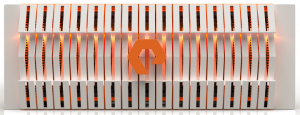![]() Today, Pure Storage, an All-Flash storage vendor, announced the General Availability (GA) of their FlashBlade, a scalable, All-Flash, NFS storage platform, as well as the GA of version 1.2 of Elasticity, the software that runs the FlashBlade.
Today, Pure Storage, an All-Flash storage vendor, announced the General Availability (GA) of their FlashBlade, a scalable, All-Flash, NFS storage platform, as well as the GA of version 1.2 of Elasticity, the software that runs the FlashBlade.
I wrote about FlashBlade when it was first announced in 2016. At the time I was very excited about the possibilities of this platform. I wasn’t able to get hands-on with the platform. The closest I got was being able to hold and examine one of the blades — encased in a Lucite box. (Really. They handed it to me all boxed up. I was tempted to use my multitool to open the box up to conduct a more-thorough examination, but not only did it feel like it would be rude, they also seemed to always make sure I was within arms-reach of at least three Pure employees at any point the blade was within arms-reach of me… (Kudos to them on having done their advance research.))
At that time, not all of the specifications had been solidified, but those details are available now.
What It Is
 The first thing to remember about FlashBlade is that it isn’t “FlashArray re-worked into a blade form-factor”. FlashBlade is a completely separate, built-new-from-the-ground-up architecture. It runs its own storage operating system, Elasticity. FlashBlade provides NFS access to files, whereas FlashArray provides iSCSI access to block storage.
The first thing to remember about FlashBlade is that it isn’t “FlashArray re-worked into a blade form-factor”. FlashBlade is a completely separate, built-new-from-the-ground-up architecture. It runs its own storage operating system, Elasticity. FlashBlade provides NFS access to files, whereas FlashArray provides iSCSI access to block storage.
Each FlashBlade chassis is 4RU tall and can hold up to 15 blades. With Elasticity 1.2, FlashBlade storage can be one or two chassis (up to 30 blades). Future releases will allow for greater numbers of chassis (I’m pretty sure that “chassis” is the plural of “chassis”…) to be combined together.
The blades come in two sizes: 8.8TB or 52TB of raw Flash storage, allowing for up to 780TB of raw Flash storage in a single chassis. Blades of differing capacities can be installed in the same chassis. Elasticity uses inline data compression to allow for a higher effective capacity. Elasticity does not currently do data deduplication, although it’s on the roadmap for a future release.
Each blade uses super-low-latency PCIe to connect the Flash chips to the blade’s processors. Blades within a chassis use an internal 10Gb Ethernet midplane for inter-blade communication. Communication between chassis occurs over the external 40Gb Ethernet ports.
Chassis Specs
The FlashBlade chassis specifications are below.
Availability
FlashBlade and Elasticity 1.2 are available starting today.
Futures
As of this writing, Elasticity only offers NFSv3 file access.
SMB file access is currently in Beta test.
S3 object access is planned to start Beta in February.
GeekFluent’s Thoughts
I only have two thoughts on this announcement:
- FlashBlade is pretty freaking cool, and is only going to get even better as additional features and means of data access get added to it.
- If anyone at Pure Storage is reading this, is there any chance there’s a FlashBlade chassis and and couple of blades sitting around idle, and any chance you’d consider donating them to become the core of the new GeekFluent Home Lab?
(Hey, it was worth a try…)

